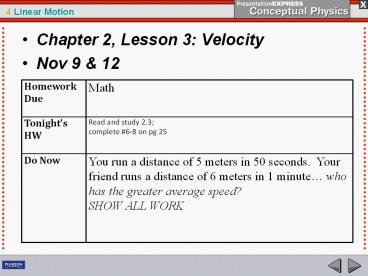Chapter 2, Lesson 3: Velocity - PowerPoint PPT Presentation
1 / 13
Title:
Chapter 2, Lesson 3: Velocity
Description:
Chapter 2, Lesson 3: Velocity Nov 9 & 12 Homework Due Math Tonight s HW Read and study 2.3; complete #6-8 on pg 25 Do Now You run a distance of 5 meters in 50 seconds. – PowerPoint PPT presentation
Number of Views:112
Avg rating:3.0/5.0
Title: Chapter 2, Lesson 3: Velocity
1
- Chapter 2, Lesson 3 Velocity
- Nov 9 12
Homework Due Math
Tonights HW Read and study 2.3 complete 6-8 on pg 25
Do Now You run a distance of 5 meters in 50 seconds. Your friend runs a distance of 6 meters in 1 minute who has the greater average speed? SHOW ALL WORK
2
- You can describe the motion of an object by its
position, speed, direction, and acceleration.
3
Concept Attainmentplease take handout
- YES
- this box will contain examples that CORRECTLY
show todays new concept
- NO
- this box will contain examples that DO NOT show
todays new concept
Your job is to come up with a hypothesis that
describes the differences between the YES and NO
examples what they ARE/ ARE NOT what they have
in common, etc. You may work in small groups if
you would like. We will ask for
groups/individuals to volunteer their hypothesis.
4
Concept Attainment
- NO
- 50 km/h
- 25 m/s
- 10 km/h
- 20 m/s
- 15 m/s
- YES
- 50 km/h north
- 25 m/s south
- 10 km/h east
- 20 m/s west
- 15 m/s northeast
You MAY work with others. Come up with a
hypothesis that describes any of the following
the differences between the YES and NO examples
what they ARE/ ARE NOT what they have in common,
etc. Random individuals/groups will be called on
to share their hypothesis.
5
2.3
Now, lets share hypotheses
- BIG IDEA (write down in 2nd box)
- Speed is a description of how fast an object
moves velocity is how fast and in what direction
it moves. - (Make note of this on Concept Attainment
handout!)
6
- Which column lists examples of
- SPEED?
- VELOCITY?
- Label on your Concept Attainment handout
- YES
- 50 km/h north
- 25 m/s south
- 10 km/h east
- 20 m/s west
- 15 m/s northeast
- NO
- 50 km/h
- 25 m/s
- 10 km/h
- 20 m/s
- 15 m/s
7
2.3 Velocity
- In physics, velocity is speed in a given
direction. - When we say a car travels at 60 km/h, we are
specifying its speed. - When we say a car moves at 60 km/h to the north,
we are specifying its velocity. - Any questions about how you labeled your columns
on your concept attainment sheet?
8
Vector vs. Scalar http//www.youtube.com/watch?v
ajTeseYcimE
- Vector magnitude (how much?) and direction
- Scalar magnitude only
- Is speed a SCALAR or VECTOR quantity?_______
- Is velocity a SCALAR or VECTOR quantity?_____
9
2.3 Velocity
- Is speed a SCALAR or VECTOR quantity?_____________
- Is velocity a SCALAR or VECTOR
quantity?_____________
Scalar (s for speed/scalar)
Vector (v for velocity/vector)
10
2.3 Velocity
- Constant Velocity
- Constant speed means steady speed. Something
with constant speed doesnt speed up or slow
down. - Constant velocity means both constant speed and
constant direction. - Constant direction is a straight line, so
constant velocity means motion in a straight line
at constant speed.
11
- Fill this in on notes
Constant Velocity Changing Velocity
To have constant velocity requires BOTH constant __________________________ and constant __________________________. If EITHER the __________________________ or __________________________ (or both) is changing, then the velocity is changing.
12
- Fill this in on notes
Constant Velocity Changing Velocity
To have constant velocity requires BOTH constant __________________________ and constant __________________________. If EITHER the __________________________ or __________________________ (or both) is changing, then the velocity is changing.
Speed
Speed
Direction
Direction
13
- Answer the rest of the questions in your Concept
Attainment in lab groups - (Check in at stop signs)
- Work efficiently!
- When you are done, you can finish your group
activity from last class and turn in for
INDIVIDUAL grades. You have until the end of
class































